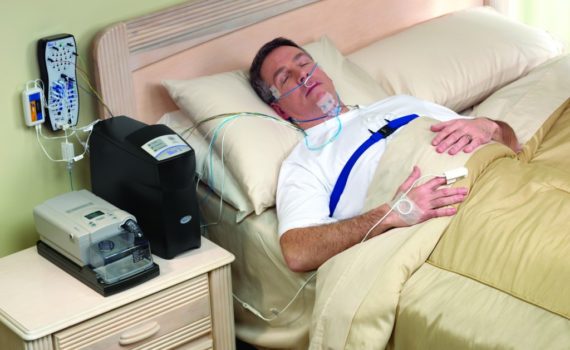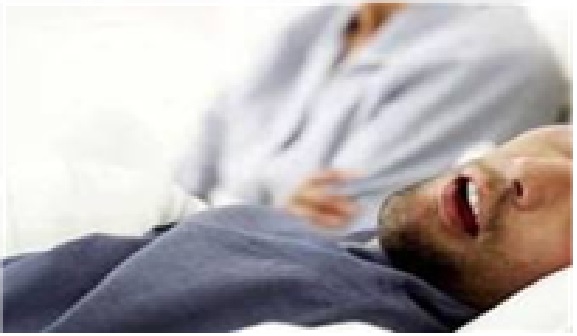Obstructive Sleep Apnea is a condition that makes you stop breathing for short periods while you are asleep. There are two types of sleep apnea. One is “obstructive sleep apnea,” and the other is “central sleep apnea.”
In obstructive sleep apnea, you stop breathing because your throat narrows or closes. In central sleep apnea, you stop breathing because your brain does not send the right signals to your muscles to make you breathe. When people talk about sleep apnea, they are usually referring to obstructive sleep apnea
Obstructive Sleep apnea occurs when you regularly stop breathing for 10 seconds or longer during sleep. It can be mild, moderate, or severe based on the number of times an hour that you stop breathing (apnea) or reduce in the airflow (hypopnea). This is the apnea-hypopnea index (AHI).
People with untreated sleep apnea stop breathing repeatedly during their sleep, sometimes hundreds of times. This means the brain — and the rest of the body — may not get enough oxygen. Patients with Obstructive sleep apnea are rarely aware of it; symptoms may be present for years or even decades without identification.
However, they do sometimes wake up startled or gasping for breath. They also often hear from loved ones that they snore. Snoring is one of the main symptoms of obstructive sleep apnea (OSA).
Furthermore, common sleep apnea symptoms include waking up with a very sore or dry throat. Loud snoring. Occasionally waking up with a choking or gasping sensation.
Sleep apnea can make you wake up in the morning feeling tired or unrefreshed even though you have had a full night of sleep. During the day, you may feel fatigued, have difficulty concentrating or you may even unintentionally fall asleep. This is because your body is waking up numerous times throughout the night, even though you might not be conscious of each awakening.
The lack of oxygen your body receives can have negative long-term consequences for your health. This includes:
High blood pressure
Heart disease
Stroke
Pre-diabetes and diabetes
Depression
This disruption in breathing can last for 10-60 seconds, and it can happen as many as 80 times per hour. At best, the sleeping disorder can result in poor sleep quality, headaches, and daytime fatigue, but at worst; it can kill you by increasing your risk of high blood pressure, heart disease, diabetes, and strokes.
Obstructive sleep apnea causes: First of all, sleep apnea a disorder where blocked airways during sleep lead to disrupted breathing and excessive snoring —affects about 3 to 7 percent of the U.S. population, with older adults more likely to be at risk. A number of factors raise the chance of having sleep apnea, including small airways, nasal congestion, and the use of alcohol or cigarettes. One of the biggest risk factors? Carrying excessive weight. In fact, about half of people with sleep apnea are overweight, leading researchers to explore the relationship between the two conditions.
Certainly, if the collapse of the airway is complete, then the breath will stops and causes apnea.
Finally, frequent apneas will lead to frequent neurological arousal, which rarely result in complete awakening, but can have a significant negative effect on the quality of sleep and the patient may suffer from fatigue and drowsiness the next day.
Factors that increase the risk of this form of sleep apnea include:
Excess weight. Obesity greatly increases the risk of sleep apnea. Fat deposits around your upper airway can obstruct your breathing.
Neck circumference. People with thicker necks might have narrower airways.
A narrowed airway. You might have inherited a narrow throat. Tonsils or adenoids also can enlarge and block the airway, particularly in children.
Being male. Men are two to three times more likely to have sleep apnea than are women. However, women increase their risk if they’re overweight, and their risk also appears to rise after menopause.
Being older. Sleep apnea occurs significantly more often in older adults.
Family history. Having family members with sleep apnea might increase your risk.
Use of alcohol, sedatives or tranquilizers. These substances relax the muscles in your throat, which can worsen obstructive sleep apnea.
Smokers are three times more likely to have obstructive sleep apnea than are people who’ve never smoked. Smoking can increase the amount of inflammation and fluid retention in the upper airway.
Nasal congestion. Finally, if you have difficulty breathing through your nose — whether from an anatomical problem or allergies — you’re more likely to develop obstructive sleep apnea.
Being older. Middle-aged and older people have a higher risk of central sleep apnea.
Being male. Central sleep apnea is more common in men than it is in women.
Heart disorders. Having congestive heart failure increases the risk.
Using narcotic pain medications. Opioid medications, especially long-acting ones such as methadone, increase the risk of central sleep apnea.
Having had a stroke increases your risk of central sleep apnea or treatment-emergent central sleep apnea.
Yes. If your doctor suspects you have sleep apnea, he or she might send you for a “sleep study.” Sleep studies can sometimes be done at home, but they are usually done in a sleep lab.
Home sleep tests. Your doctor might provide you with simplified tests to be used at home to diagnose sleep apnea. These tests usually measure your heart rate, blood oxygen level, airflow and breathing patterns. If the results are abnormal, your doctor might be able to prescribe a therapy without further testing
For the hospital study, you spend the night in the lab, and this is the polysomnography.
Finally, polysomnogram is an overnight sleep study. A trained sleep technician will prepare you for the test and apply sensors to the head, face, chest, abdomen, and legs. None of these devices hurt, then the doctor will monitor the physiological indicators during sleep including brain waves, heart rate, breathing rate, and oxygen level.

Sleep apnea treatment may include making lifestyle changes, oral appliances, surgeries or using cpap while you sleep.
First of all, there is a variety of treatments for OSA. This involves lifestyle changes. Special appliances that are placed in the mouth can help those with mild-to-moderate sleep apnea. These appliances prevent the tongue from blocking the throat and help move the lower jaw forward during sleep
There are a variety of lifestyle changes that you can make to help you reduce your snoring and improve your sleep apnea symptoms. Lifestyle changes may include losing weight (if overweight), avoiding alcohol, quitting smoking and sleeping pills, sleeping on your side, using nasal sprays or breathing strips, and avoiding sleep deprivation. Alcohol relaxes your throat muscles which can cause you to snore or for your airway to collapse. If you have allergies, taking a decongestant before you go to bed may help improve airflow through your nose.
If you have difficult staying with your treatment plan or cannot sleep even with treatment, your doctor may recommend Cognitive Behavioral Therapy. A behavioral sleep specialist will help you eliminate the thoughts and behaviors that are preventing you from getting restful sleep or complying with your treatment.
Positional therapy is a behavioral strategy to treat positional sleep apnea. Some people have sleep apnea primarily when sleeping on their back. The “supine” position. Their breathing returns to normal when they sleep on their side. Positional therapy may involve wearing a special device around your waist or back. It keeps you sleeping in the side position. Another option is a small device that uses “vibro-tactile feedback” technology. Worn on the back of the neck, it gently vibrates when you start to sleep on your back. Without waking you up, the vibration alerts your body to change positions. Positional therapy is good alone or together with another sleep apnea treatment.
An oral appliance is a device that fits in your mouth over your teeth while you sleep. It may resemble a sports mouth guard or an orthodontic retainer. The device prevents the airway from collapsing by holding the tongue in position or by sliding your jaw forward so that you can breathe when you are asleep. Some patients prefer sleeping with an oral appliance to a CPAP machine. A dentist trained in dental sleep medicine can fit you with an oral appliance after you are diagnosed with sleep apnea
Your doctor may suggest some surgeries to treat sleep apnea if you have swollen tonsils and adenoids that block your airway during sleep. This is often the first treatment choice for children. That’s because swollen tonsils and adenoids are often the cause of their sleep apnea.
In some patients, surgical procedures effectively reduce sleep apnea in those who have too much soft tissue or malformed tissue that blocks the airflow through the nose or throat. Surgical options can range from nasal surgery to improve breathing to help adjust to CPAP, restructuring of the throat tissue to lessen collapse, or even a nerve stimulation implant to open the airway

The most effective treatment for sleep apnea is a device that keeps your airway open while you sleep. The device name is continuous positive airway pressure or CPAP.
Continuous positive airway pressure (CPAP), in which a face mask is attached to a tube and a CPAP machine that blows pressurized air into the mask and through the airway to keep it open. so CPAP prevents airway closure while in use, but apnea episodes return when CPAP is stopped or it is used improperly. Many types and styles of devices are available. Some patients are not able to adhere to CPAP due to pressure intolerance. Patients who cannot tolerate CPAP may benefit from other types of pressure delivery devices
The CPAP motor is a small compressor. It draws in room temperature air and gently pressurizes it to deliver the perfect amount of air pressure that you need to clear your obstruction. Most CPAP machines also have a small water tank that, when turned on, heats up the water to provide moisture to the air you breathe in. These built-in humidifiers are ideal for people living in dry climates. CPAP motors are extremely quiet
Using CPAP to treat your sleep apnea can improve your life and make each day better.